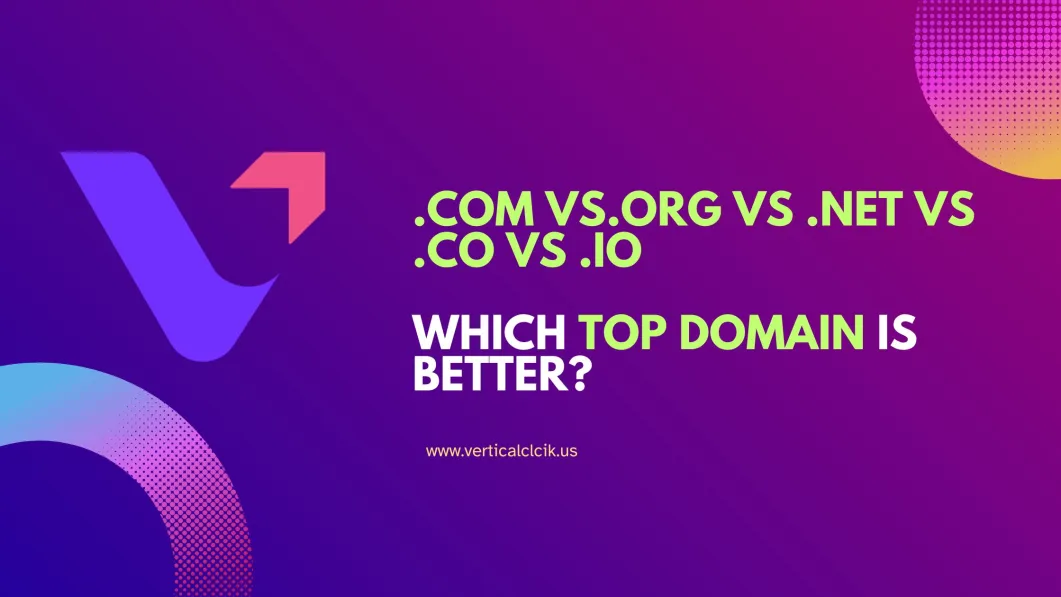.COM vs .ORG vs .NET vs .CO vs .IO – Which Top-Level Domain is Better?

In launching a website, one of the first things one will have to decide on is finding the right TLD. The code that appears at the end of a web address, like .com,.org,.net, or.io, is known as the top-level domain (TLD). Even though the TLD is a small decision, it can have an impact on your site’s SEO, brand identity, and credibility. So which one is best for you? Let’s go to the key differences and use cases for each.
.COM-The Gold Standard
The meaning of .com stands for “commercial”. It is currently the most well-known and reliable TLD available online. Since its inception in 1985, it has been the address given to any business, personal brand, blog, and almost every kind of website.
Pros:
- Universally recognized and easy to remember.
- Instills trust and credibility in the visitors.
- Preferred by users and search engines.
Cons:
- Many names are already taken; therefore, finding a unique .com name can become difficult.
- Premium .com domain names can cost an arm and a leg.
- Best for: Any purpose where much of the audience is being reached out to on important matters.
- .ORG-For Nonprofit and Community Purposes
Originally meant for nonprofit organizations, .org has aptly established itself as the domain for charities, educational projects, and open-source communities.
Pros:
- Trusted by users seeking social impact or educational content.
- Less competition than .com, thus increasing the availability of names.
Cons:
- A good use may confuse users into thinking it is a commercial enterprise.
- That said, perception of noncommercial may not be right for all brands.
- Standout Uses: Nonprofits, Advocacy Groups, Education Content, Community-focused Platform.
- .NET-Technical Legacies
.net, short for “network,” was originally intended for internet service providers and tech companies. It has gradually become a popular alternative to.com, particularly when the desired.com domain is unavailable.
Pros:
- Users are aware of it and have some degree of faith in it.
- Works fairly well for tech-based businesses or service platforms.
Cons:
- Still kind of seen as second-best to .com.
- lacks the authority and brand weight of .com.
- Best for: Tech companies, start-ups, and those involved with web services, especially if it has something to do with infrastructure or networking.
- CO-Start-Up Friendly, Modern For All
.co is really the country code for Colombia, but it has been marketed on an international platform as an abbreviation for ‘company.’ Its sharp and short nature makes it a loud choice among start-ups and modern businesses.
Pros:
- Short and brandable.
- Available domain names are easier to find compared to .com.
- It looks modern and stylish.
Cons:
- Could be mistaken for a typo of com.
- Outside start-ups or tech, less recognized.
- Best for: Start-ups, entrepreneurs, and new businesses that wish to carry a sleek and modern image.
- .IO-The Darling of Techies
.IO is the country code for the British Indian Ocean Territory, but it has gained traction and popularity in the tech domain and with start-ups and software companies. The abbreviation IO obviously relates to input/output, making it appealing to software users and developers.
Pros:
- Popular within the tech and SaaS space.
- Modern and trendy for the early-adopter crowd.
- Good availability for names.
Cons:
- Higher registration fees.
- Some general users still find it unfamiliar.
- Being tied to a geopolitical location could be a turnoff for some.
- Best for: SaaS platforms, developers, tech start-ups, and those working with innovative digital products.
Choose.com to maximize trust, familiarity, and SEO value.
Which top-level domain will you select?
- If your cause is nonprofit or community-focused, select .org.
- Choose .net if your field is technical in nature and .com is not available.
- You might want to think about .co, as it gives a modern, start-up-friendly vibe.
- The best use of .io is for tech targeting, especially aimed at developers or early adopters.
Conclusion
Ultimately, your domain is an important component of your brand identity. Truth be told, the TLD will neither make nor break you, but picking one that best fits your goals and audience can send the right message from the get-go. A web address’s TLD is the code that appears at the end: .com, .org, .net, .co, or .io. Even though the TLD is a minor consideration, it can have an impact on your site’s SEO, brand identity, and legitimacy.